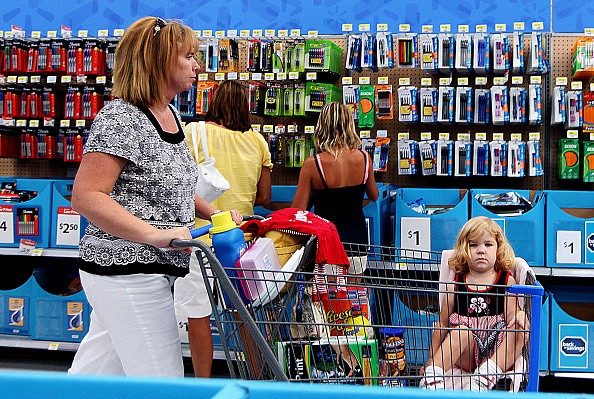

Tony Rogers is senior vice president and chief marketing officer of Walmart U.S. and oversees an integrated marketing effort across Walmart Stores and Walmart.com. Tony recently talked to SheReports about holiday season marketing at the world’s biggest retailer.

What are you seeing as this year’s trends in holiday marketing?
First is we’re seeing that it’s turning into an omnichannel affair. It’s so clear that to win this holiday — and in general — you can’t be pure-play e-commerce and you can’t be pure-play brick-and-mortar. You’ve got to figure out how to blend the two together.
We talk a lot about convenience. For our customer, convenience has risen to essentially the same level of importance as price.
The interesting thing about convenience is [that] it’s situational. Sometimes convenience is I want it delivered to my front door and I don’t want to leave my couch. Sometimes it’s I want that store down the street to be open 24/7 so I can go get it right now. Sometimes it’s I want to order it online, but I want to go pick it up because I don’t want it sitting on my front porch.
We talk a lot about convenience. For our customer, convenience has risen to essentially the same level of importance as price.
All of our research is telling us that our customers are looking for somebody who can cover them across all their different need states.
The other thing we’re seeing — and it’s a continuation of a trend we’ve been seeing for a while — is that people are researching sooner, but they’re delaying their purchases. It’s a gradual trend, but you see these dual activities of I’m going to do my research way out in advance. But when it comes to doing the actual purchasing, we see a whole lot of activity at the very beginning of the season, then we see a little bit of a lull, and then we see a whole lot of activity around in the last few days leading up to Christmas.
And how do you take advantage of those insights?
As you might imagine, there’s a lot of activity in our company around building the omnichannel muscle and linking the digital to the physical.
We purchased Jet.com last year, and we’ve been integrating that team into our team. This will be really our first holiday with this new structure from the marketing standpoint, and it’s allowing us to move resources around pretty seamlessly across our media plan. We have conversations about [whether or not] I spend a dollar on television, print, search or social. It’s the first time we’ve been able to look across all those different channels and treat them equally in the discussion and have the conversation holistically, because before I would have had different budgets, different org charts.
As you might imagine, there’s a lot of activity in our company around building the omnichannel muscle and linking the digital to the physical.
Are you seeing a trend that all your marketing will be moving to digital?
I think there’s always going to be a balance. Each of these channels plays its own role in the marketing mix. For example, we’re launching all kinds of new services. Free two-day shipping. Pick up in the stores. Easy reorder. If I’m just trying to drive awareness that I have free two-day shipping, then television is always going to be a great marketing vehicle for me. Nothing better than TV to drive broad awareness of something fast.
On the other hand, if I’m trying to get you down in the purchase funnel, maybe you purchased from me and I’m trying to accelerate the journey to the next purchase, or maybe I’m trying to get you to purchase a complementary item. For things like that, I’m going to utilize digital tools.
How do these insights inform marketing to a female consumer?
The majority of our purchasing is done by females. So when we talk about our customer, we tend talk about our female customer first. We identify our core target as what we call “busy families.” They’re young families with kids in the household. People trying to basically get life done with limited funds and limited time. And in those busy families we tend to focus primarily on the female shopper, because she’s the one making most of the purchase decisions.
The majority of our purchasing is done by females. So when we talk about our customer, we tend talk about our female customer first.
Let me give you an example. One of the things we’re seeing really resonate with all customers, in particular with our female customers, is our online grocery pick-up service. This is where you can order your groceries online and come pick them up at the store. We’ve rolled this to about a thousand of our stores, and we’re going to be rolling it out aggressively in the next couple of years.
Of everything we’re doing in the company, this is probably getting the most positive response from our customers. If you’ve got a car full of kids, there are times when you don’t want to have to get out of the car. Being able to pull up and have somebody load your groceries in the back of your car and be gone in a matter of minutes, our customers are telling us that’s a real game changer.
We’re not just focused on our female customer; we’re really focused on having females on our team, and female advertising and media partners too.
We feel like if the customer that we’re trying to talk to is predominately female, then we need to make sure that we’re well represented with female leadership internally and externally. It infuses into the entire leadership team a higher level of empathy and understanding for what the customer is going through. It provides a more accurate sounding board for ideas and for creative approaches.
We’re not just focused on our female customer; we’re really focused on having females on our team, and female advertising and media partners too.
Walmart is famous for its greeters. Where do you come down on “Merry Christmas” versus “Happy Holidays” as a greeting?
We say “Merry Christmas.” Our signs say “Merry Christmas.” It’s not really a controversial issue with our company or our customers.
But we’ve instituted a thing at our stores over the last couple of years, which we’re expanding this year, called Holiday Helpers. These are associates who are specially trained to help customers go find things they are looking for, get information on products, get them to that checkout lane with the shortest line or get them into self-checkout faster. And they’re “Holiday Helpers” because of that awfully awesome alliteration.
More From the December 2017 Travel Issue of SheReports:
- SheReports Interview: On Earning Trust and Understanding Women
- SheReports Research and Insights: Finance and Gender
- SheReports Research and Insights: Marketing to Women
- Email Marketing
- Old-Fashioned Retail
- Black Friday
- #SheDidThat: The Judds

